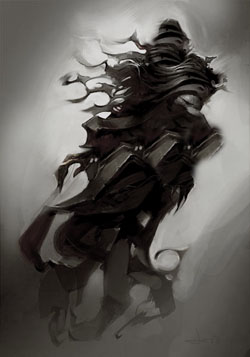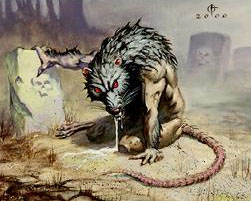From “The Psychology of Immersion” by Jamie Madigan:
The game world also needs to behave as you’d expect it to. “Consistency is the single most important factor in creating a real sense of place,” says Josh Foreman, an experienced designer at ArenaNet who works on the Guild Wars games. “The style can be anything from photo-real to abstract to impressionism, as long as there is an internal logic to what the player perceives.” This means that in-game characters, objects, and other aspects of the world should behave like their real-world counterparts.
Interesting to read this in the context of dissociated mechanics in paper ‘n pencil roleplaying games.
Filed under: Random, Roleplaying Games | Comments (2)
 During the Search for Varla the players quickly realized that they were dealing with a foe who could reanimate the dead, so they made a point of incinerating the corpses they left behind.
During the Search for Varla the players quickly realized that they were dealing with a foe who could reanimate the dead, so they made a point of incinerating the corpses they left behind.
(Fun fact: In OD&D, a fire ball spell has a duration of 1 turn. The only possible explanation is that the spell creates a raging inferno that lasts for 10 minutes.)
I decided, however, that the powerful necromantic energies surrounding Atarin’s Delve were capable of raising even these insignificant remains. This prompted the on-the-fly creation of ash wraiths — animate clouds of corpse ash.
They particularly appeal to me because they provide an incorporeal form of undead that can be used in a fashion similar to skeletons and zombies. (In other words, minor undead that aren’t mind-searingly terrifying in their level-draining devastation.)
As with the lycanthropic ghouls from yesterday, the ash wraiths use a combination of AD&D stat block and OD&D verbiage.
Frequency: Rare
No. Encountered: 3d10
Move: 12″
Armor Class: 6
Hit Dice: 1+1
Attacks: 1d6
Special Attacks: Nil
Special Defenses: +1 or better weapon to hit
Magic Resistance: Not subject to fire-based attacks
% in Lair: 40%
Treasure Type: Nil
Intelligence: Low
Alignment: Neutral
Ash wraiths are born from the burnt remains of corpses. They are most often found haunting ruined crematoriums or lingering near the horrors of execution pyres, but there are also tales of woods being haunted by ash wraith animals for years or even decades after the devastation of forest fires.
Ash wraiths cannot properly be said to have any corporeal body, which makes them totally impervious to all normal weaponry (although they can be struck by all magical weapons). Their touch, however, retains the passionate heat of their deaths and is scalding to mortal flesh.
Filed under: Roleplaying Games | Comments (10)
 In “Tales from the Table: Gems in the Belly” yesterday, I mentioned the use of wererat ghouls in my restocking of Atarin’s Delve. Here’s what those look like (using a mixture of an AD&D stat block with OD&D verbiage):
In “Tales from the Table: Gems in the Belly” yesterday, I mentioned the use of wererat ghouls in my restocking of Atarin’s Delve. Here’s what those look like (using a mixture of an AD&D stat block with OD&D verbiage):
Frequency: Rare
No. Encountered: 4d6
Move: 9″
Armor Class: 6
Hit Dice: 2
Attacks: 1d3/1d3/1d6
Special Attacks: Ghoul touch, vestigial lycanthropy, surprise on 1-4
Special Defenses: Immune to sleep and charm spells
Magic Resistance: Standard
% in Lair: 20%
Treasure Type: B
Intelligence: Low
Alignment: Chaotic Evil
Ghoul Touch: Wererat ghouls paralyze any normal figure they touch, excluding elves. Any man-type killed by a ghoul becomes one.
Vestigial Lycanthopy: Anyone seriously wounded by an undead lycanthrope (assume about 50% of total possible damage) will be infected and himself become a similar lycanthrope within 2d12 days unless they are given a cure disease spell by a cleric. A saving throw may be made, with a +4 bonus due to the vestigial nature of the lycanthropic infection.
Filed under: Roleplaying Games | Comment (1)
I’m preparing to run some combat stress tests in order to put the monster creation rules in Legends & Labyrinths through their final paces. In order to do that, I would like to get my hands on high level character sheets from actual play.
Let me explain what I mean by that: What I want are actual 3.0/3.5 characters who are 10th level or higher and reached that level by earning experience points at the gaming table and leveling up in an organic way. They don’t necessarily need to have started at 1st level, but I’d prefer to see characters who have seen at least 4-5 levels of actual play.
What I don’t want are pregens or characters that were freshly rolled up at higher levels. I’ll be doing some testing with those, too, but they’re easy to find or create.
(Why do I want ’em? In my experience, characters who are created at higher levels tend to look significantly different than characters who have leveled up to those levels. The organic process of gaining loot and shifting your intended character build in response to the campaign’s events creates different characters than those who are given an equipment budget and allowed to build to a focused spec in a single sitting. And while I’ve got samples from my own games, I’m specifically interested in getting a wide sampling of what the organic processes at other tables created.)
If the sheets are online, you can link me to ’em in the comments. Otherwise drop me an e-mail with “[Character Sheet]” in the subject line. (You can find my e-mail address on the About page.) I don’t particularly care what format they’re in, but I’m particularly interested in the equipment lists so don’t leave those out.
Also: The more the merrier. And if you’ve got multiple versions of the same character at different levels, send ’em all.
If you send me a sheet, I’ll be crediting you as a “Playtest Assistant” unless you tell me not to.
Thanks!
(I don’t need additional external playtesters at this time. When I do, I’ll be posting something about it here.)
Filed under: Roleplaying Games | Comments (10)
There are quite a few older D&D modules that feature various creatures with gemstones or gold coins or magical items lodged in their gizzards. I was never a big fan of the idea: First, it seemed weird. Second, it seemed improbable that any of my players would actually hack open one of these creatures and find the treasure. Third, if they ever did find one of these treasures it would only prompt them to go around systematically gutting every corpse they created.
Admittedly, the “kill ’em and loot ’em” mentality has never been particularly heroic. But advancing that into the territory of butchering your enemies in the hope that something valuable might be squeezed out of their intestines just seems to take things to a new level of tastelessness.
But this is the tale of how, after twenty years of gaming, I ended up putting a gemstone in a gizzard.
And it’s not my fault.
SPOILERS FOR MY PLAYERS BELOW THIS LINE
(more…)
Filed under: Roleplaying Games | Comments (5)













